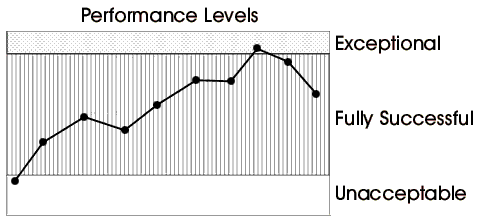U.S. Office of Personnel Management - Ensuring the Federal Government has an effective civilian workforce
Performance Management
Archive
How to Measure the Results of Work Teams
by Jack Zigon; Zigon Performance Group, 1995.
A team needs to know how its results will help the organization. Individuals on the team need to know what the team requires of them to reach the team's goal. The seven-step process for measuring team performance presented by Jack Zigon in How to Measure the Results of Work Teams provides a method for linking the team's goals to the organization's, and for linking the individual's goals to the team's so they are mutually supportive.
Terminology. Readers who are subject to Federal appraisal regulations should note that Zigon uses the terms "performance standards," "goals," and "objectives" interchangeably and sees them as descriptions of some future, desirable state that the team is trying to achieve. Rather than describe a narrow, pinpointed level of performance, the standards Zigon uses as examples establish a wide range of acceptable (or fully successful) performance. As depicted below, performance below the standard is considered unacceptable, and performance exceeding the standard is considered exceptional.

Translating these standards into Federal appraisal terminology, Zigon appears to be recommending the appraisal of performance elements using a minimum of three levels, with a broadly defined fully successful standard.
Seven-Step Process. Zigon presents a seven-step process for creating performance standards for teams.
- Review existing organizational measures. Ensure that the measures above and around the team are known and linked to the team's measures.
- Define what's going to be measured. Zigon offers four alternatives for identifying what the team needs to measure. He comments that selecting the best alternatives and using them to identify the team's key accomplishments provide the basis for all further measurement. (See discussion below.)
- Identify individual team member accomplishments that support the team. Identify the results each team member must produce to support the team's results or work processes.
- Weight the accomplishments. Discuss and agree upon the relative importance of each accomplishment.
- Develop team and individual performance measures. Identify the measurement (either numeric or descriptive) that will be used to gauge how well the results have been achieved.
- Develop team and individual performance standards. Define how well the team and individuals have to perform to meet expectations.
- Decide how to track performance. Identify how the data for each performance standard will be collected and fed back to team members
Measurement Points. Elaborating on step two of his seven-step process, Zigon describes four ways to identify what should be measured. (Zigon refers to these as measurement points.) These methods can be used singly or in combination:
- If the team exists to satisfy the requirements of its customers, the measurement point(s) should be the product or service the team provides to the customer.
- If the team exists to help the organization make an improvement in a specific measurable goal, the measurement points should be determined by asking, "What value-added results does the team produce that can help the organization achieve its goal?"
- If the team exists to support the organization's function, the measurement point(s) are determined by identifying the hierarchy of results that the organization must produce and selecting those that link the team to the organization's results.
- If the team is used to support a work process, the measurement points are found by mapping the process and using the map to identify what's worth measuring.
The first three methods of identifying measurement points listed above focus on measuring accomplishments. (Even the fourth method, which focuses on work process, looks at the results of work at critical places in the process.) Zigon defines work results as accomplishments end products, not activities. Accomplishments are what is left behind when you go home; they take the form of nouns, not verbs. Because his method focuses on measuring accomplishments and results, readers will not find examples of behavioral measures (often used in 360-degree appraisal approaches). However, his method should fit well with agencies aiming at organizational goals and customer satisfaction.
In summary, managers and teams looking for guidance on measuring the results of work teams or groups will find this book extremely helpful.
Originally published on June 1996